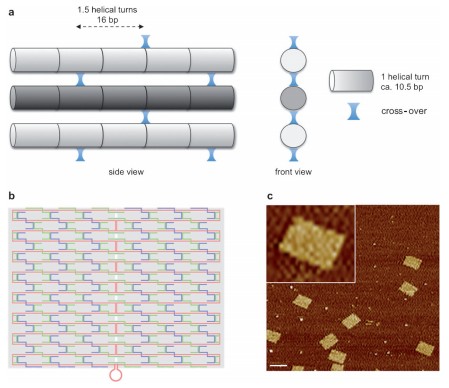DNA Origami
In 1982 Seeman proposed using DNA as a construction material for the assembly of geometrically defined objects with nanoscale features. DNA-origami technique folds a long single-stranded DNA strand (scaffold) into a desired shape with the help of hundreds of short oligonucleotides, called staple strands.
Single-Layer DNA Origami
In the original study of Rothemund,6 several planar origami structures were produced, ranging from simple rectangular shapes to more complex forms, such as stars, triangles, as well as nongeometric figures such as smiley faces. These objects were generated by following a common design rule: every helix within the structure is connected to two neighboring helices by a regular pattern of cross-overs interspaced by 1.5 helical turns, which for a B-type DNA corresponds to about 16 base pairs (Figure 1). This register of cross-overs generates interhelical connections every 180°, thus leading to a single layer of helices arranged into a planar sheet.
Applications of DNA Origami
DNA-origami structures could be used as molecular pegboards for arranging arbitrary objects of interest with nanometer precision. Interactions and/or transformation of the arrayed objects, such as nucleic acids, small-molecules, proteins, or nanoparticles, can be analyzed by single-molecule techniques, although, in some cases, even bulk measurements can be carried out.
References
1. Chenxiang Lin, Yan Liu Dr., Sherri Rinker, Hao Yan Prof. Dr. DNA Tile Based Self-Assembly: Building Complex Nanoarchitectures
2. Dr. Barbara Saccà*, Prof. Dr. Christof M. Niemeyer* DNA Origami: The Art of Folding DNA
